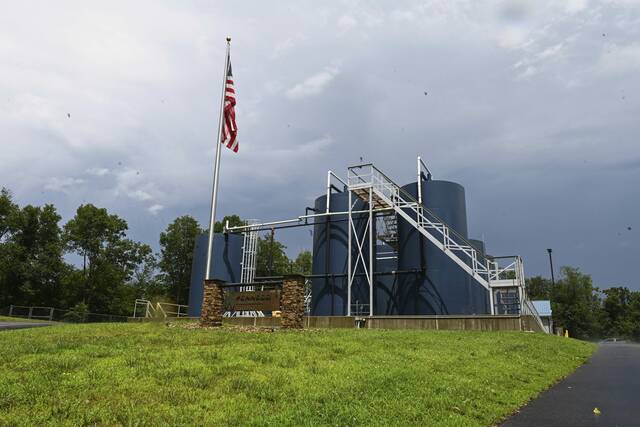https://triblive.com/local/valley-news-dispatch/an-inside-look-at-plums-controversial-fracking-wastewater-injection-well/
An inside look at Plum’s controversial fracking wastewater injection well

The wastewater injection site in Plum run by Penneco Environmental Solutions has been the subject of nearly a decade of legal battles and community backlash as the company has sought to expand its operations along Old Leechburg Road.
Since 2017, the borough and Penneco have been at odds, as the company first constructed one injection well at its facility after years of litigation and soon applied to build a second.
The oil company took its latest step in the conflict just over a week ago, when it filed an appeal in Allegheny County court to Plum Zoning Hearing Board’s rejection of a variance for that second well.
But throughout the process, basic facts surrounding the site’s function, safety and effects on the community around it have been the cause for volleys of claims and counterclaims in court and among neighbors.
Here’s a detailed look at Penneco’s 70-acre hilltop facility and some of the concerns of those who oppose it.
What is an injection well?
Injection wells are used to shoot liquids deep into the earth for industrial or disposal purposes. The site in Plum is a Class II injection well, meaning it’s used for the disposal of waste products related to oil and gas production.
Penneco’s site in Plum disposes of brine — salt water found deep underground that’s extracted in large amounts during oil and gas drilling.
Brine, normally sequestered between layers of earth, can contain toxic metals and radioactive materials, according to the Environmental Protection Agency. That means the material can be highly damaging to local environments if it’s discharged on the surface.
To dispose of brine, injection wells pipe the material hundreds or thousands of feet underground into formations where the water is meant to stay isolated from local water sources. In the case of Penneco’s site in Plum, the well injects brine between two impermeable layers of shale about 1,900 feet beneath the surface.
“We like to say we’re returning brine to its home,” Penneco Chief Operating Officer Ben Wallace said.
The EPA estimates 180,000 Class II wells operate in the United States.
How does the site in Plum operate?
Penneco’s site in Plum has three lanes for vacuum trucks to drive up and feed wastewater into numerous tanks throughout the facility.
The company mostly accepts brine from fracking sites around Butler and other Western Pennsylvania towns, but some trucks also arrive with loads from the eastern half of the state, according to Wallace.
Once the trucks arrive, they display a manifest and an identifying number to the site operator to make sure drivers don’t deliver unauthorized loads, Senior Vice President of Operations Marc Jacobs said.
The wastewater is initially filtered to remove large solids before it enters a Coriolis meter, which measures the properties and contents of the water, Wallace said.
Prior to its placement in initial storage tanks, Wallace said, the brine is injected with a biocide to kill any bacteria and a corrosion inhibitor to protect the facility’s piping.
The brine then sits in long, low-to-the-ground tanks to allow smaller solids to separate and sink to the bottom, Wallace said.
After that, wastewater is piped to taller storage tanks, as any remaining hydrocarbons are isolated and sent to a different tank.
The COO said Penneco sells the hydrocarbons it skims from the brine back to refineries.
“We actually don’t mind if companies bring us oil because it’s free money,” Wallace said.
Left with dirty brine with some small solids remaining, Wallace said, operators shoot the water through 10- and 25-micron filters to catch some of the frack chemicals, tiny shale remnants and dirt.
Those solids are then dried, checked for a radioactive signature and tossed in a dumpster, Wallace said.
The brine, on the other hand, is piped back to different storage tanks to await injection, he said.
For the final act, the brine is shot through another pipe at around 1,200 psi down a hillside to the actual injection well.
There, it descends 1,900 feet below the surface to a layer of sand between two shale formations.
During busy seasons, Jacobs said, the facility will draw about 30 trucks each day, but during the summer, less than half of that might arrive to offload.
So far, Wallace said, the company had injected 3.2 million barrels — or 134 million gallons of brine — beneath Plum.
Safety measures
Essentially any abnormality will trigger an automatic shutdown of the facility, according to Keith McDowell, Penneco’s plant operation manager. That means no water can be accepted or proceed through the injection process.
Most of the systems at the plant are automated with each computerized step of the process dependent on the previous one to allow it permission to proceed, McDowell said.
Numerous sensors and cameras also send constant data to the phones of company executives, he said.
During a TribLive visit to the site, for example, a nearby lightning strike triggered a vibration sensor, causing the facility to lock down and send a notification to McDowell’s phone.
The sensors that allow the process to proceed are both digital and analog.
In terms of transport, most pipes in the facility are fitted with several internal layers, Wallace said.
In the injection well itself, there are four concurrent pipes, which are separated by layers of cement and monitoring fluid. Brine is injected down the center-most pipe, which is 2⅞ inches wide. If a leak or other fluid change were to cause a pressure difference of 1 pound, McDowell said, the facility would automatically shut down.
In terms of the facility’s footprint, Wallace called the site a “black hole.” The truck offloading area is sloped down to catch any leaking water in a trench drain that guides brine through the same injection pipes, Jacobs said.
Wallace said the facility’s filtration building, storage tanks and offloading area sit above a “large bathtub,” with an enormous plastic tarp below layers of earth and clay to halt any water that seeps through the concrete.
The site also maintains two seismic monitors because of concerns about small earthquakes caused by underground fracking or disposal activities.
To monitor pressure, the injection well has digital and liquid-filled gauges as well as a pressure chart recorder that keeps constant tabs on the well, McDowell said.
Wallace described the well as a “digital system surrounded by an analog bubble.”
Community concerns
Still, Plum residents and officials have consistently objected to the site, which does handle potentially harmful materials in their backyards.
Nearby neighbors often have raised concerns about the potential for water pollution, foul odors and noise from offloading trucks.
In 2021, a report from the DEP said it could not connect pollutants in a resident’s well water to activity related to the injection well or oil and gas production.
But Dylan Basescu, a staff attorney at environmental advocacy group Protect PT, said his organization was concerned that injection activity may have disturbed the subsurface in the area, causing preexisting contaminants to enter neighboring wells.
Protect PT, which aids residents with environmental concerns through Westmoreland and Allegheny counties, has assisted the borough with its legal case against Penneco’s proposed second well since 2021.
An environmental scientist at the organization, Yvonne Sorovacu said Protect PT had been monitoring the air around the site for volatile organic compounds (VOCs), sometimes harmful emissions often noticed in the form of foul odors.
Though she said the group can’t make a definitive connection between the VOCs it detected and the injection well, she said residents only began reporting odors after the first well went online in 2021.
“We cannot conclusively determine where those are coming from, but we do see high levels there happen periodically that are unusual to detect at a residential location,” Sorovacu said.
In a statement, Allegheny County spokesperson Abigail Gardner said the county health department previously had investigated odor complaints near the site. She said inspectors had smelled an odor close to a tank at the facility, but “no odors were observed in public areas or beyond the property line.”
Gardner said no violations were observed during the inspection.
Another cause for concern is the potential for brine migration underground, Sorovacu said.
Though Penneco’s senior vice president said it would be “physically impossible” for brine to move upward to contaminate ground water, recent concerns at similar sites in Ohio have raised questions about containment.
The Ohio Department of Natural Resources has shuttered several Class II injection wells for brine surfacing from below ground as well as subsurface leaks flooding nearby oil production wells.
Sorovacu said incidents like those show that brine injection isn’t a foolproof process.
“(The risk) is materials that our human bodies are not supposed to be exposed to ending up in places where we are exposed to it,” she said.
Protect PT community advocate and retired attorney Jim Cirilano said there is also evidence of a “mechanical failure” early in the lifetime of Penneco’s injection well, which he said is a red flag.
Wallace said the supposed failure was the result of a faulty piece of equipment near the injection site that had been causing pressure spikes. After the company replaced the part, he said, the well hasn’t experienced issues of that sort.
According to a DEP report about the incident, the department found no brine had leaked into groundwater, and the EPA had confirmed the reinstalled well’s integrity.
According to DEP Regional Communications Manager Laina Aquiline, one violation has been recorded against the site.
The violation states that Penneco had received a complaint about a potentially polluted water supply from someone near the site in July 2021. The company had given notice to the EPA, but had not submitted a report to the DEP, as required.
Aquiline said the DEP had determined, however, that oil and gas activity was not responsible for an impact to the water supplies.
EPA spokesperson Eric VanHorn said Penneco has maintained compliance with its permit conditions and his agency has no concerns with the facility.
But the concerns about safety, Cirilano said, are only one part of the argument against the site. He said residents simply don’t want a potentially dangerous industrial plant near their homes.
“Everything that they’re saying about this being a safe thing and that they haven’t done anything wrong is kind of missing the point,” Cirilano said. “This is an industrial use that is in an area that is residential, and it has the potential to cause harm to people where they live.”
On that much, Wallace and Cirilano may agree.
Without many definitive links between safety concerns and the Penneco site, Wallace said, the reason for the community’s resistance simply comes down to an aversion to their industry.
“I think they’re just being obstructionist,” he said. “It’s just political theater, and it’s a little bit of hatred.”
However long the appeals process lasts, the company, borough and Protect PT have each expressed confidence in their cases and have vowed to see it through until one side prevails.
Copyright ©2026— Trib Total Media, LLC (TribLIVE.com)
